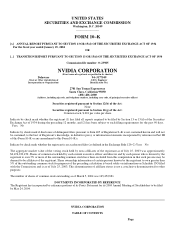NVIDIA 2004 Annual Report Download - page 7
Download and view the complete annual report
Please find page 7 of the 2004 NVIDIA annual report below. You can navigate through the pages in the report by either clicking on the pages listed below, or by using the keyword search tool below to find specific information within the annual report.
combine scalable architectural technology with mass market economies−of−scale to deliver a complete family of products that spans
workstations to low−cost value PCs to mulitmedia−rich mobile phones.
Our objective is to be the leading supplier of performance GPUs, MCPs and UMPs for a broad range of desktop PCs, workstations,
notebooks, video game consoles, Internet appliances, handhelds and any future computing device with a display. Our current focus is
on the desktop PC, workstation, notebook PC, mulitmedia−rich mobile phones and game console product lines, and we plan to expand
into other product lines. Our strategy to achieve this objective includes the following key elements:
Build Award−Winning, Architecturally−Compatible 3D Graphics, Media Communications and Ultra−Low Power Product Families
for the PC, Handheld and Digital Entertainment Platforms. Our strategy is to achieve market share leadership in these platforms by
providing award−winning performance at every price point. By developing 3D graphics and media communications solutions that
provide superior performance and address the key requirements of these platforms, we believe that we will accelerate the adoption of
3D graphics and rich digital media. As part of our strategy, we have closely aligned our product development with Direct3D and
OpenGL, which we believe maximizes third−party software support. Direct3D and OpenGL are application programming interfaces,
or APIs, that enable software developers to write their applications to a standard without specific knowledge of hardware
implementations.
3
Target Leading OEMs, ODMs and System Builders. Our strategy is to enable our leading OEM, ODMs and major system builder
customers to differentiate their products in a highly competitive marketplace by using our digital media processors. We believe that
design wins with these industry leaders provide market validation of our products, increase brand awareness and enhance our ability to
penetrate additional leading customer accounts. In addition, we believe that close relationships with OEMs and ODMs will allow us to
better anticipate and address customer needs with future generations of our products. For example, our GPUs are currently designed
into products offered by virtually every leading branded PC OEM, including Acer, Inc., or Acer, Apple Computer, Inc., or Apple, Dell
Computer Corporation, or Dell, eMachines, Inc., or eMachines, Fujitsu−Siemens Computers, or Fujitsu−Siemens, Gateway, Inc., or
Gateway, Hewlett Packard Company, or HP, International Business Machines, Inc., or IBM, Micron Electronics, Inc. , or Micron,
NEC Corporation, or NEC, SGI, and Sony Corporation, or Sony.
Sustain Technology and Roadmap Leadership in 3D Graphics and Video, and Media Communications and Ultra−Low Power. We
are focused on leveraging our advanced engineering capabilities to accelerate the quality and performance of 3D graphics and video,
media communications and ultra−low power processing in PCs and handheld devices. A fundamental aspect of our strategy is to
actively recruit the best 3D graphics and video, networking and communications engineers in the industry, and we believe that we
have assembled an exceptionally experienced and talented engineering team. Our research and development strategy is to focus on
concurrently developing multiple generations of GPUs, MCPs and UMPs using independent design teams. As we have in the past, we
intend to leverage this strategy to achieve new levels of graphics, networking and communications features and performance and
ultra−low power designs, enabling our customers to achieve award−winning performance in their products.
Increase Market Share. We believe that substantial market share will be important to achieving success. We intend to achieve a
leading share of the market by devoting substantial resources to building award−winning families of products for a wide range of
applications.
Leverage Our Expertise in Digital Multimedia. We believe the synergy created by the combination of 3D graphics and video and the
Internet will fundamentally change the way people work, learn, communicate and play. We believe that our expertise in
high−definition graphics and system architecture positions us to help drive this transformation. We are leveraging our expertise in the
processing and transmission of high−bandwidth digital media to develop products designed to address the requirements of
high−bandwidth concurrent multimedia.
Sales and Marketing
Our worldwide sales and marketing strategy is a key part of our objective to become the leading supplier of performance GPUs, MCPs
and UMPs for PCs and handheld devices. Our sales and marketing teams work closely with OEMs, ODMs, system integrators,
motherboard manufacturers, add−in board manufacturers and industry trendsetters, collectively our Channel, to define product
features, performance, price and timing of new products. Members of our sales team have a high level of technical expertise and
product and industry knowledge to support a competitive and complex design win process. We also employ a highly skilled team of
application engineers to assist the Channel in designing, testing and qualifying system designs that incorporate our products. We
believe that the depth and quality of our design support are key to improving the Channel’s time−to−market, maintaining a high level
of customer satisfaction within the Channel and fostering relationships that encourage customers to use the next generation of our
products.
In the segments we serve, the sales process involves achieving key design wins with leading OEMs and major system integrators and
supporting the product design into high volume production with key ODMs, motherboard manufacturers and add−in board
manufacturers. These design wins in turn influence the retail and system integrator channel that is serviced by add−in board and
motherboard manufacturers. Our distribution strategy is to work with a number of leading independent contract equipment
manufacturers, or CEMs, ODMs, motherboard manufacturers, add−in board manufacturers and stocking representatives, each of




















